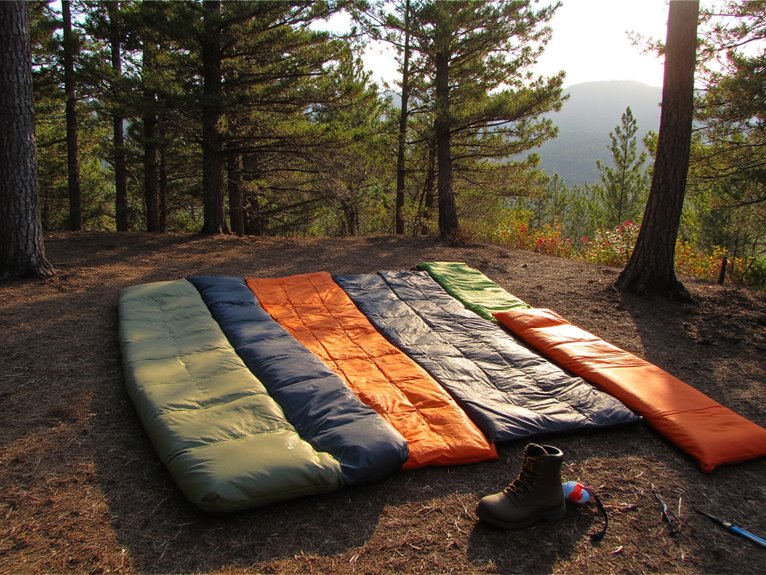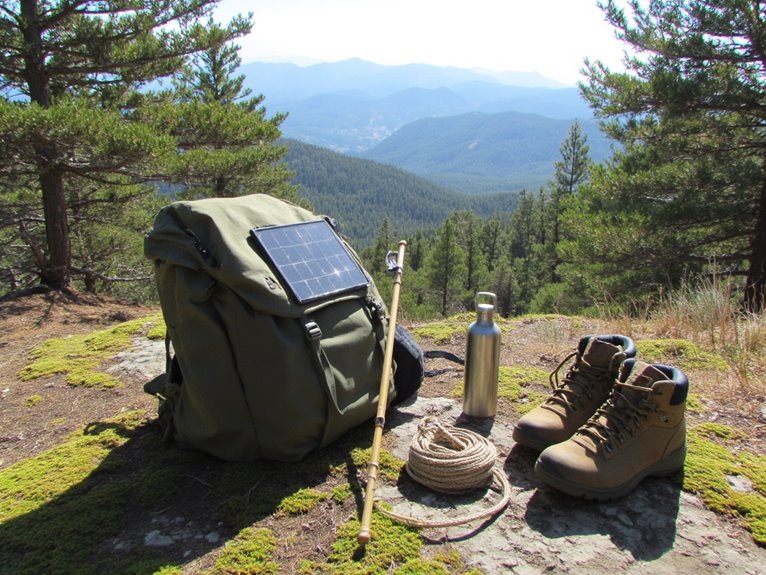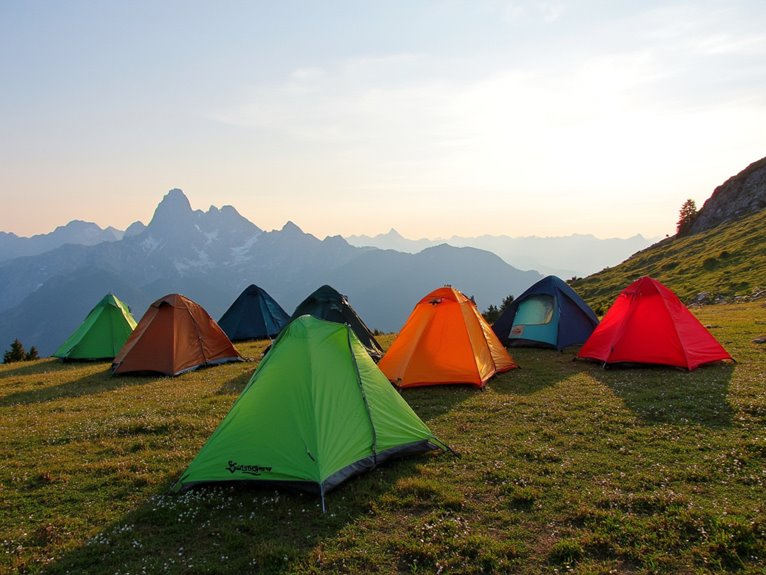10 Best Lightweight Backpacking Sleeping Pads for Ultimate Comfort on the Trail
I’ve tested dozens of lightweight backpacking sleeping pads, and the best options balance weight, insulation, and comfort effectively. Top performers include the Yuzonc with built-in foot pump for rapid setup, POWERLIX ultralight models weighing under 20 ounces, and ATEPA’s 6 R-value pad for cold-weather protection. Look for 40D nylon construction, R-values matching your conditions (2-3 for summer, 4+ for cold), and thickness between 2-4 inches. Continue exploring to discover specific specifications and performance details for each recommendation.
We are supported by our audience. When you purchase through links on our site, we may earn an affiliate commission, at no extra cost for you. Learn more. Last update on 6th December 2025 / Images from Amazon Product Advertising API.
Notable Insights
- Target ultralight pads weighing 14-20 ounces that compress to water bottle size for optimal backpacking performance.
- Choose thickness of 3+ inches and appropriate R-values (2-3 summer, 4+ cold weather) for maximum comfort and insulation.
- Look for 40D nylon construction with reinforced seams and high-grade valves to ensure durability on rugged terrain.
- Consider built-in foot pumps or pump bags for quick inflation without carrying additional equipment or using lung power.
- Balance weight savings with comfort needs based on sleeping position, trip duration, and expected ground conditions.
Yuzonc Camping Sleeping Pad with Built-in Foot Pump
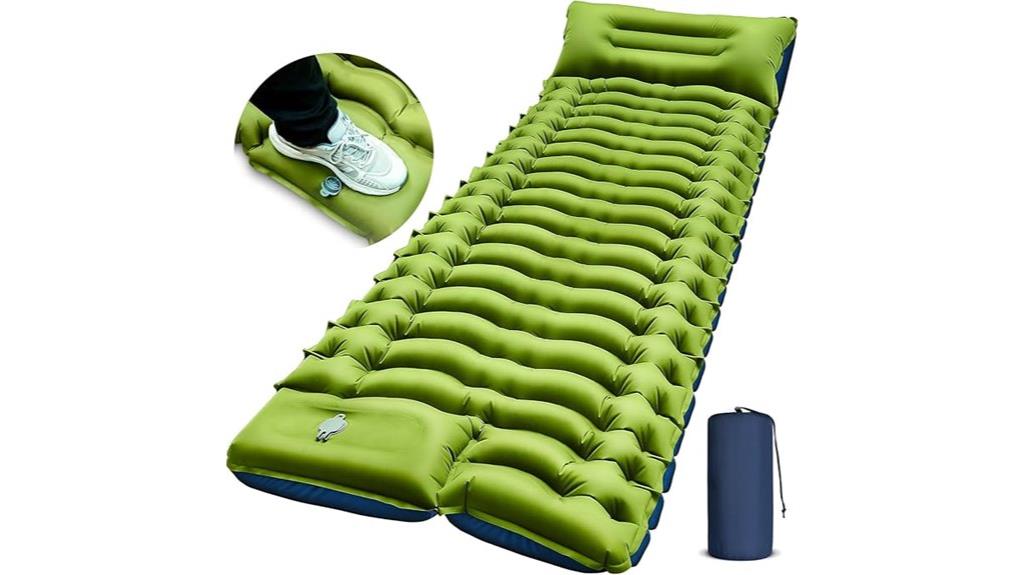
The Yuzonc Camping Sleeping Pad stands out as an exceptional choice for backpackers who prioritize convenience and speed during setup, since its integrated foot pump eliminates the need for external inflation devices or lung-taxing manual inflation. You’ll achieve full inflation in 30-60 seconds using simple foot pressure, then deflate everything in one second via the upgraded double-layer air release valve.
At 1.5 pounds and 78*27*3 inches, you’re getting substantial sleeping real estate without pack weight penalties. The 40D nylon exterior with TPU sealing handles 400-pound capacity while resisting tears. Innovative egg-shaped air cells provide targeted support for your back and neck, accommodating both side and back sleeping positions comfortably.
Best For: Backpackers and campers who need a lightweight, quick-inflating sleeping pad with built-in convenience features for fast setup and packdown.
Pros:
- Built-in foot pump inflates the pad in 30-60 seconds without external equipment or mouth inflation
- Lightweight at 1.5 pounds with generous 78*27*3 inch dimensions and 400-pound weight capacity
- Innovative egg-shaped air cells and built-in pillow provide targeted support for back and neck
Cons:
- Size consistency issues reported by some customers
- Reduced insulation performance in cold weather conditions
- Variable inflation methods may require adjustment based on user preference
POWERLIX Ultralight Inflatable Camping Sleeping Pad
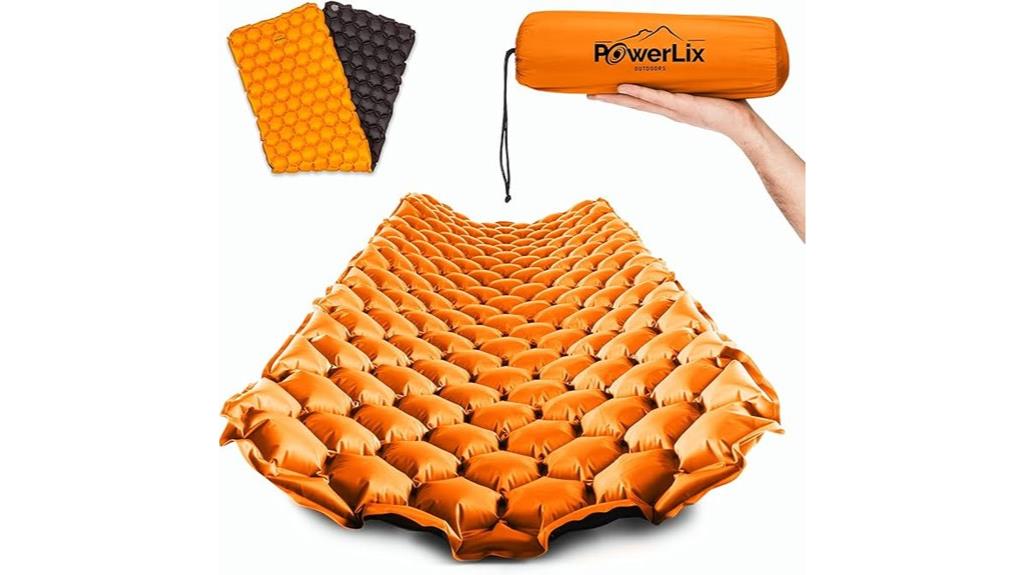
Budget-conscious backpackers who prioritize ultralight gear without sacrificing comfort will find exceptional value in POWERLIX’s Ultralight Inflatable Camping Sleeping Pad. At 1.9 pounds, this pad measures 74.8 inches long by 22.83 inches wide with 1.5-inch thickness. You’ll appreciate the revolutionary hexagon design with body mapping technology that supports pressure points effectively. The included pump bag inflates the pad in 8-10 pumps through a dual-action, non-leak air valve. You’ll get excellent portability as it rolls up small for backpack storage. The outdoor-grade, waterproof materials provide thermal insulation from cold ground. Side sleepers may find it firmer than expected.
Best For: Budget-conscious backpackers and hikers who need ultralight gear and prioritize portability over maximum cushioning.
Pros:
- Ultralight at 1.9 pounds with compact design that rolls up small for easy backpack storage
- Quick and easy inflation in 8-10 pumps using the included dual-purpose pump bag
- Revolutionary hexagon design with body mapping technology provides effective pressure point support
Cons:
- At 1.5 inches thick, it’s less cushy than thicker airbeds or foam mats
- Side sleepers may find the pad firmer than expected and less comfortable
- Mixed user reviews regarding ease of inflation despite manufacturer claims
Ultralight Inflatable Sleeping Pad for Camping and Hiking
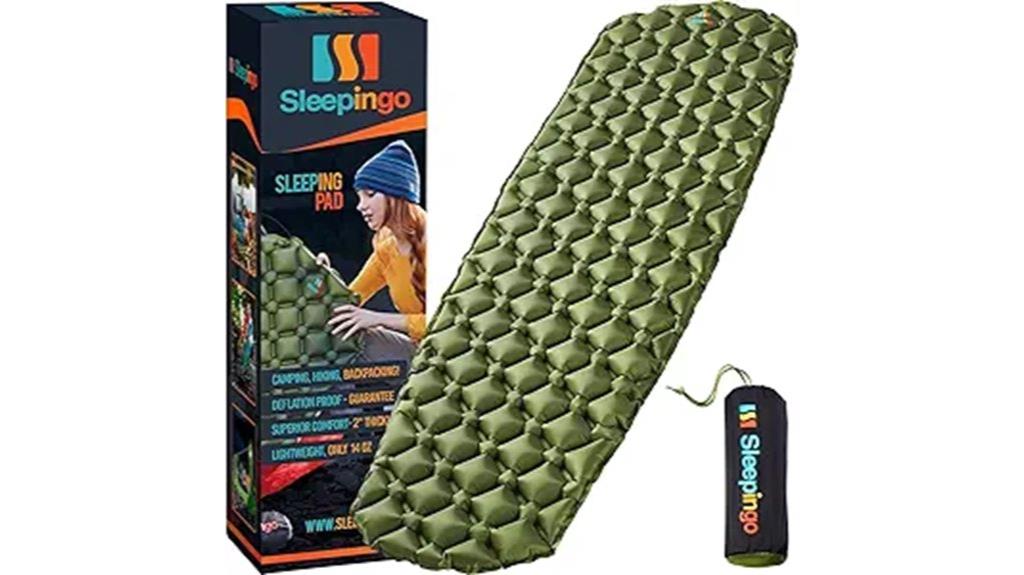
Minimalist backpackers who prioritize every ounce in their pack will find exceptional value in ultralight inflatable sleeping pads that weigh less than one pound. This 74×22-inch sleeping pad compresses smaller than a water bottle yet expands to provide 2-inch padding for peak pressure distribution. The waterproof ripstop nylon construction withstands rocky terrain and extended outdoor use.
Air cell technology guarantees even body support across all sleeping positions. You’ll appreciate how this pad accommodates back, side, and stomach sleepers equally well. The compact design fits easily in your hand when deflated, making it ideal for long-distance hiking where pack space matters. This combination of ultralight weight and reliable comfort makes it essential gear for serious adventurers.
Best For: Minimalist backpackers and long-distance hikers who need ultralight, compact sleeping gear without sacrificing comfort or durability.
Pros:
- Weighs less than 1 pound and packs smaller than a water bottle for maximum portability
- 2-inch thick air cell design provides even body support for all sleeping positions
- Waterproof ripstop nylon construction resists wear and handles rocky terrain
Cons:
- May require careful handling to prevent punctures despite durable material
- Inflation and deflation time adds setup steps compared to foam pads
- Limited insulation value may require additional gear in cold conditions
Camping Sleeping Pad, 4in Thick Ultralight Inflatable Mat with Pillow
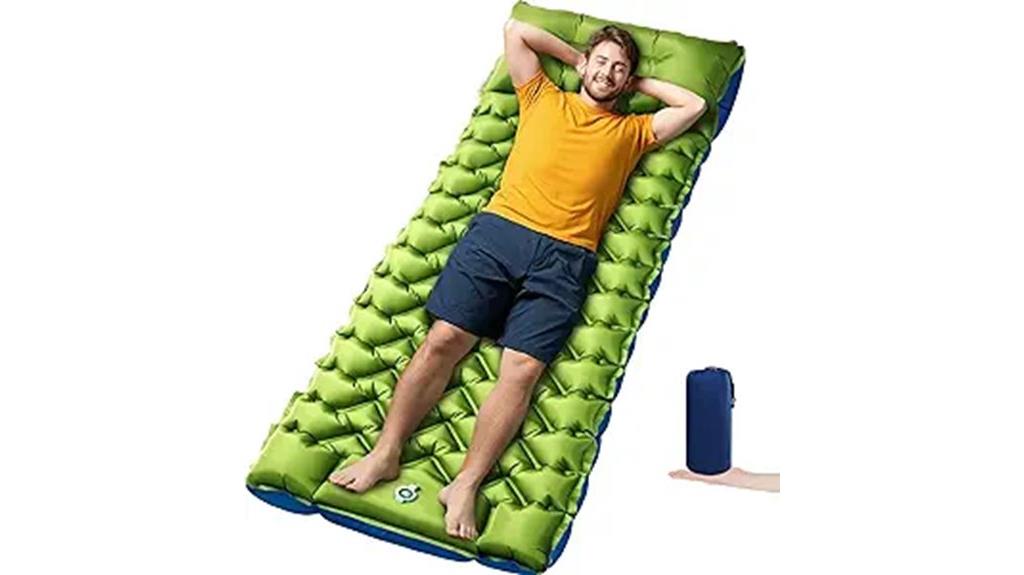
Side sleepers looking for comfortable ground clearance will find this 4-inch thick ultralight inflatable sleeping pad addresses their specific pressure point concerns. The V-shaped support system keeps your hips and shoulders suspended above ground contact, eliminating hard surface pressure. You’ll appreciate the built-in foot pump that inflates the pad in 30 seconds—five times faster than manual methods. At 1.9 pounds and packing down to 9.4×4.3 inches, it won’t burden your pack. The 40D nylon construction resists punctures across varied terrain while supporting up to 400 pounds. The integrated pillow contours to your neck’s natural curve.
Best For: Side sleepers and casual campers who prioritize comfort and quick setup over ultralight weight savings and need reliable ground clearance for pressure point relief.
Pros:
- Ultra-fast 30-second inflation with built-in foot pump eliminates manual effort and back strain
- 4-inch thickness with V-shaped support keeps hips and shoulders suspended above hard ground
- Compact pack size (9.4×4.3 inches) and lightweight design (1.9 lbs) won’t overload hiking packs
Cons:
- Lacks insulation rating, making it unsuitable for cold weather camping below moderate temperatures
- At 1.9 pounds, it’s heavier than premium ultralight pads preferred by serious backpackers
- No mention of warranty coverage or long-term durability testing for extended use
NEAR ZERO Ultralight Inflatable Sleeping Pad for Backpacking
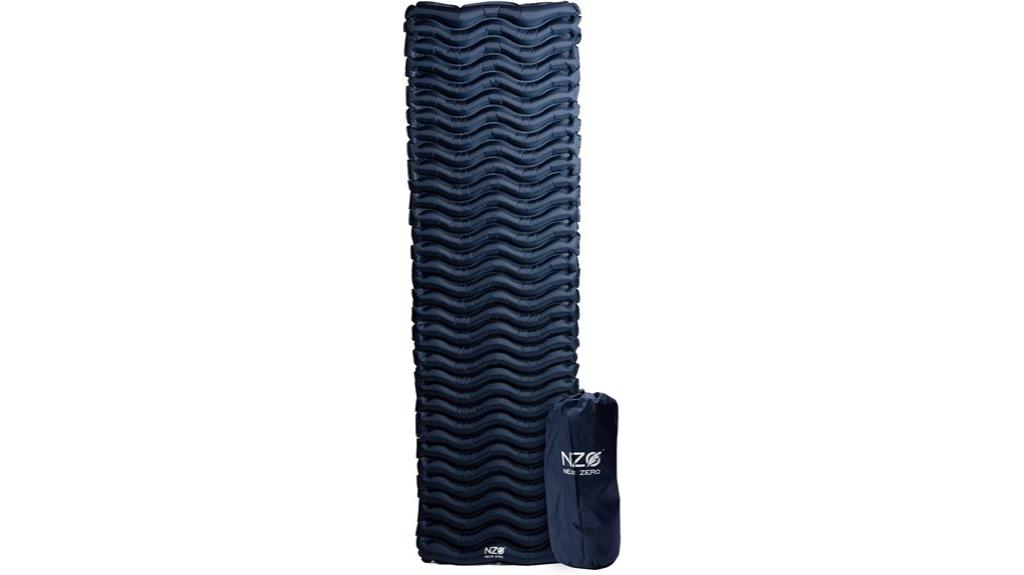
Ultralight enthusiasts who count every ounce in their pack will find the NEAR ZERO Ultralight Inflatable Sleeping Pad delivers impressive weight savings at just 14.5 ounces. You’ll get 2.2 inches of cushioned thickness when inflated to its full 75 x 23-inch dimensions. The water-resistant, rip-resistant nylon construction handles rough terrain effectively.
Inflation requires only 11 breaths through the efficient valve system. You can deflate quickly for rapid camp breakdown. The pad compresses to a compact 8 x 3.5-inch package that won’t dominate your pack space. This makes it ideal for weight-conscious backpackers tackling multi-day adventures where every ounce matters for performance and endurance.
Best For: Ultralight backpackers and hikers who prioritize weight savings and compact packing without sacrificing sleeping comfort on multi-day outdoor adventures.
Pros:
- Exceptionally lightweight at 14.5 oz with compact 8 x 3.5-inch packed size for minimal pack space
- Quick and easy setup requiring only 11 breaths to fully inflate through efficient valve system
- Durable water-resistant and rip-resistant nylon construction handles rough outdoor conditions
Cons:
- Limited customer reviews (only 1 rating) make it difficult to assess long-term reliability and performance
- At 2.2 inches thick, may provide less cushioning than thicker alternatives for side sleepers or those needing extra comfort
- Manufactured in China which may raise quality control concerns for some users seeking domestic products
NEAR ZERO Ultralight Inflatable Sleeping Pad for Backpacking
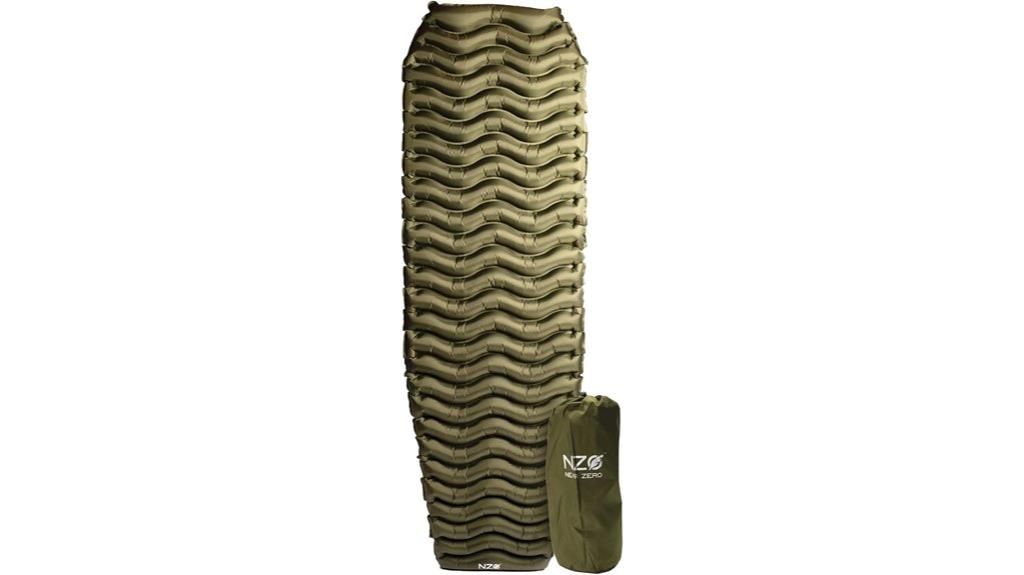
When every ounce matters on extended backcountry trips, the NEAR ZERO Ultralight Inflatable Sleeping Pad delivers essential comfort without the weight penalty that plagues traditional camping gear. At 14.5 ounces, this pad packs down to 8 x 3.5 inches while inflating to 75 x 23 x 2.2 inches thick. You’ll achieve full inflation with just 11 breaths through the integrated valve system. The water-resistant nylon construction provides durability against trail conditions. Customer ratings average 4.3 out of 5 stars across verified purchases. The 2.2-inch thickness offers adequate cushioning for side sleepers on uneven terrain, making it suitable for three-season backpacking adventures.
Best For: Ultralight backpackers and hikers who prioritize weight savings and pack size while still needing adequate sleeping comfort for three-season camping trips.
Pros:
- Exceptionally lightweight at 14.5 oz with compact 8 x 3.5 inch packed size ideal for backpacking
- Quick and easy inflation requiring only 11 breaths through integrated valve system
- Water-resistant nylon construction provides durability against trail conditions
Cons:
- Limited 2.2-inch thickness may not provide sufficient cushioning for all sleeping positions on rocky terrain
- Some customer reports indicate actual dimensions may vary slightly from advertised specifications
- Lacks insulation properties making it less suitable for cold weather camping
ATEPA Backpacking Sleeping Pad, 3.3 R-Value Inflatable Ultralight Camping Mattress
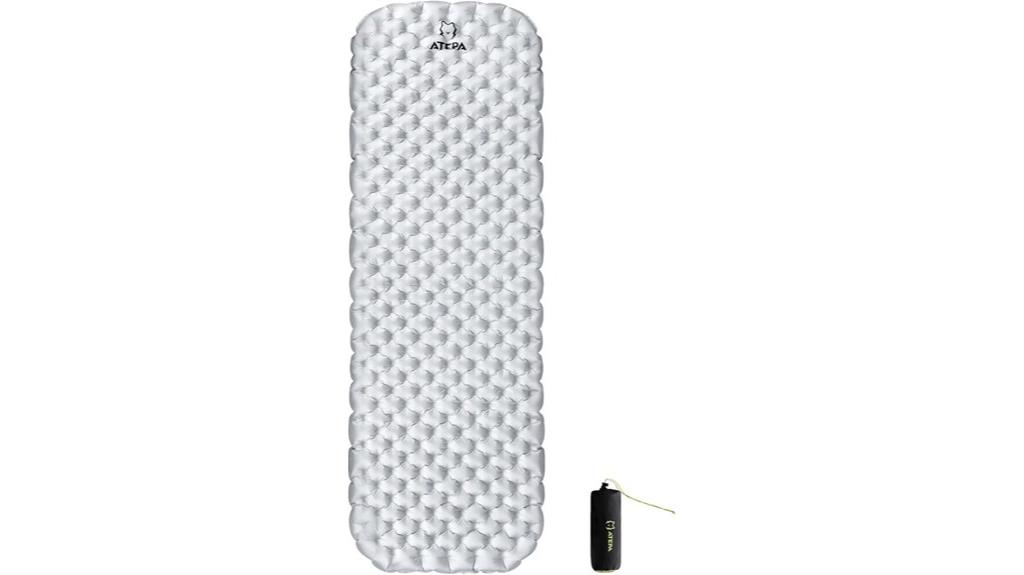
Budget-conscious backpackers who prioritize comfort without breaking the bank will find the ATEPA Backpacking Sleeping Pad delivers solid performance at an accessible price point. This 78×25.6-inch pad weighs 1.54 pounds and packs down to 11×5.1 inches—roughly a Nalgene bottle’s size. The 3.3 R-value provides adequate three-season insulation through its built-in aluminum layer. You’ll inflate it with 25-30 breaths using the TPU safety valve. The tear-resistant nylon construction withstands rugged conditions, while waffle-style baffling enhances comfort for side sleepers. At 3.2 inches thick, it offers solid cushioning for rocky terrain without ultralight weight penalties.
Best For: Budget-conscious backpackers and campers who want reliable three-season comfort and packability without paying premium prices for ultralight gear.
Pros:
- Excellent value with 3.3 R-value insulation, durable construction, and compact pack size at an accessible price point
- Quick and easy setup with 25-30 breath inflation and user-friendly TPU safety valve for fast deflation
- Comfortable 3.2-inch thickness with waffle-style baffling that works well for side sleepers on rough terrain
Cons:
- Heavier than comparable ultralight pads at 1.54 pounds, making it less ideal for weight-conscious backpackers
- Requires manual inflation without self-inflating capability, though pump compatibility helps
- Limited to three-season use with 3.3 R-value, not suitable for winter or extreme cold conditions
ATEPA Backpacking Sleeping Pad, 6 R-Value Insulated Ultralight Inflatable
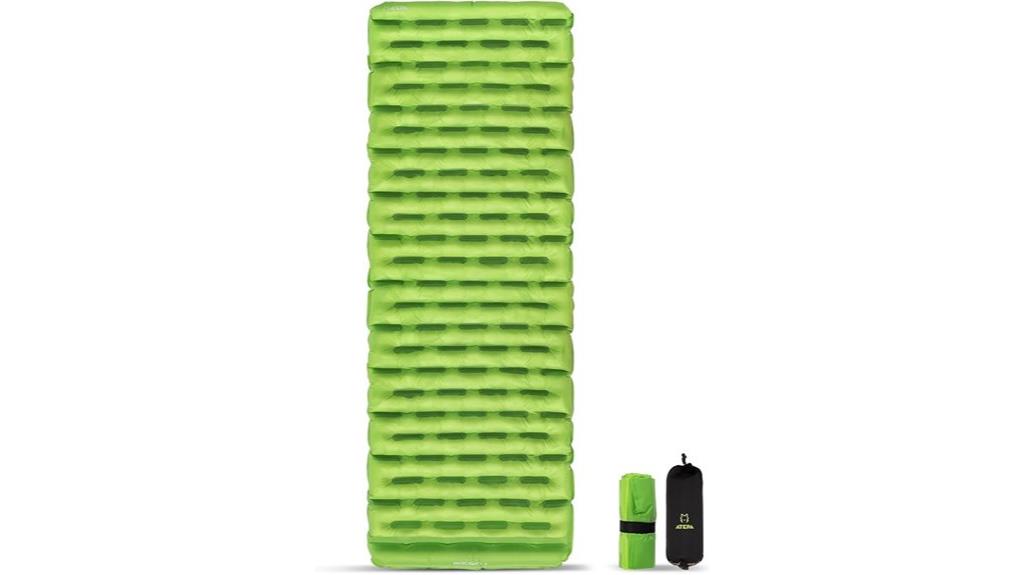
The ATEPA Backpacking Sleeping Pad targets serious four-season adventurers who demand reliable warmth in harsh conditions. You’ll get an R-value of 6, rated for temperatures down to -20°C (-4°F). The 7-layer construction features aluminum insulation with I-Beam design for support.
At 1.54 pounds and 9cm thick, you’re carrying substantial comfort. The 72×25-inch surface accommodates all sleeping positions. It packs down to 23x11x11cm—roughly water bottle size. The included pump sack eliminates extra gear needs.
However, user feedback reveals mixed insulation performance. While comfortable in warmer conditions, some report inadequate warmth despite the claimed R-value rating during cold-weather testing.
Best For: Backpackers who prioritize comfort and portability for three-season camping but shouldn’t rely on it for extreme cold weather conditions despite its claimed 6 R-value rating.
Pros:
- Excellent portability at just 1.54 pounds with compact pack size comparable to a water bottle
- Comfortable 3.5-inch thickness with I-Beam construction that accommodates all sleeping positions
- Convenient included pump sack and two-in-one valve system for easy setup without additional gear
Cons:
- Mixed user feedback indicates insulation performance may not meet the claimed R-6 rating in cold conditions
- At 1.54 pounds, it’s heavier than some ultralight alternatives for weight-conscious backpackers
- Durability concerns with 20D nylon material for rugged outdoor use compared to thicker fabrics
Sleeping Pad with Pillow, Self Inflating Ultralight Sleeping Mat with Built-in Pump
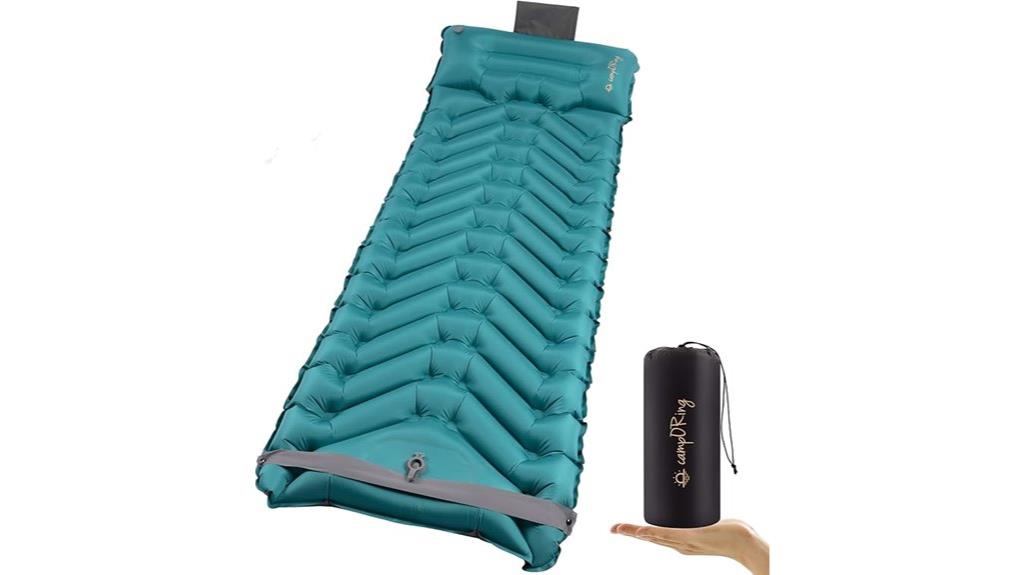
CampORing’s Sleeping Pad with Pillow delivers exceptional comfort for backpackers who refuse to sacrifice sleep quality for weight savings. This self-inflating mat measures 77L x 27W x 4T inches while weighing just 1.9 pounds. The built-in foot pump inflates the pad in under one minute, eliminating breath-powered inflation fatigue.
The 4-inch thickness incorporates body mapping technology that supports pressure points effectively. You’ll appreciate the 40D nylon polyester construction with multi-layer TPU coating, providing an R-value of 2.4 for three-season use. The integrated pillow reduces your pack weight further.
When packed, it compresses to 12×5 inches—roughly water bottle size. The waterproof design handles wet conditions, while reflective strips enhance nighttime visibility.
Best For: Backpackers and campers who prioritize comfort and convenience without adding significant weight to their pack, especially those camping in three-season conditions.
Pros:
- Ultra-fast inflation with built-in foot pump (under 1 minute) eliminates the need for manual breath inflation
- Excellent thickness-to-weight ratio at 4 inches thick while weighing only 1.9 pounds
- Integrated pillow and compact 12×5 inch packed size reduces overall gear requirements
Cons:
- R-value of 2.4 limits use to three-season camping and may not provide adequate insulation for winter conditions
- At 27 inches wide, it may feel narrow for larger individuals or side sleepers who move frequently
- Foot pump mechanism adds potential failure points compared to simpler self-inflating designs
GearDoctors Ether Ultralight Sleeping Pad for Camping & Backpacking
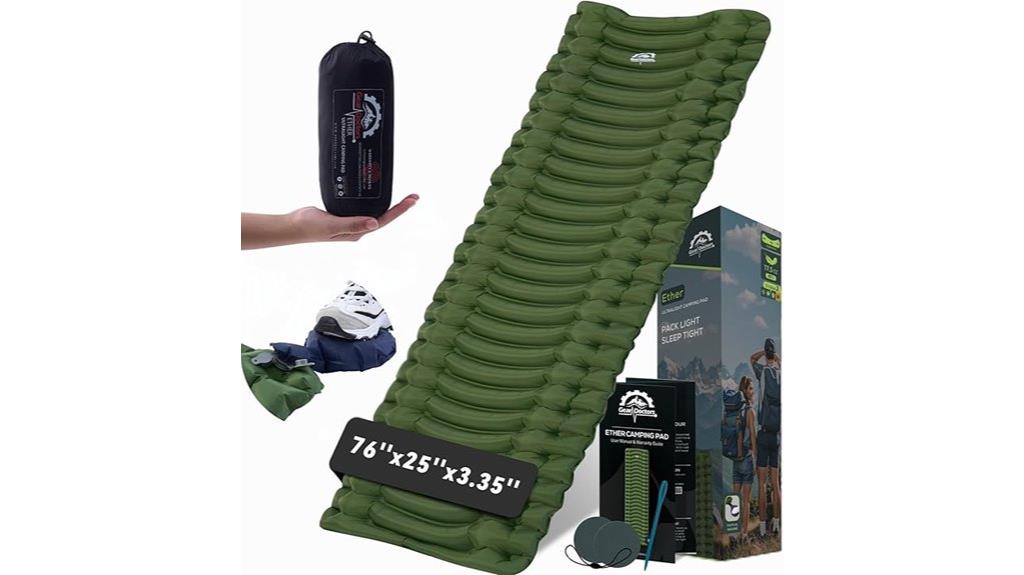
Serious backpackers who prioritize weight savings without sacrificing comfort will find the GearDoctors Ether Ultralight Sleeping Pad delivers exceptional performance at just 17.5 ounces. When packed, it’s comparable to a water bottle at 8.6″ x 3.1″. The pad inflates to 76″ x 25″ with ErgoCushion contours measuring 3.35″ at edges, tapering to 2.36″ center thickness.
You’ll appreciate the detachable foot pump that achieves full inflation in under 90 seconds without lung power. The ergonomic U-shape design prevents slipping for side and back sleepers, supporting up to 440 pounds. Heavy-duty 20D Nylon construction with TPU coating guarantees durability, while the 2-R value provides adequate warmth for spring and summer conditions.
Best For: Serious backpackers and hikers who prioritize ultralight gear without compromising comfort for spring and summer camping trips.
Pros:
- Exceptionally lightweight at 17.5 oz with compact water bottle-sized packed dimensions
- Quick 90-second inflation using detachable foot pump eliminates need for manual lung inflation
- Ergonomic U-shape design with ErgoCushion contours prevents slipping and accommodates side/back sleepers
Cons:
- Limited to spring and summer use due to low 2-R insulation value
- Some users report noise issues and require careful air pressure management for optimal comfort
- Reports of slow leaks from some customers despite durable construction claims
Factors to Consider When Choosing a Lightweight Backpacking Sleeping Pad
When I’m selecting a lightweight backpacking sleeping pad, I evaluate five critical factors that directly impact my comfort and pack weight on the trail. Weight and packability determine how much space the pad consumes in my pack, while R-value specifications tell me exactly how much thermal insulation I’ll get from ground cold. The pad’s thickness affects comfort on rocky terrain, material durability impacts long-term reliability, and inflation methods range from breath-powered to integrated pumps that affect setup time and effort.
Weight and Packability
Although comfort matters on the trail, weight and packability often determine whether you’ll actually carry a sleeping pad on your backpacking adventures. I recommend targeting pads between 14-20 ounces for peak performance without excessive bulk. This weight range delivers functional insulation while keeping your pack manageable during long approaches.
Packability proves equally critical. Quality lightweight pads compress to approximately 8 x 3.5 inches or smaller—roughly water bottle dimensions. This compact profile fits easily into most hiking packs without consuming valuable space needed for essential gear.
However, I must emphasize the weight-comfort trade-off. Ultralight options often sacrifice thickness and cushioning to achieve minimal weight. You’ll need to balance your desire for pack weight reduction against potential sleep quality issues on rocky or uneven terrain.
R-Value and Insulation
Understanding R-value becomes critical when selecting a lightweight backpacking sleeping pad, as this standardized metric directly determines your insulation from cold ground temperatures. Higher R-values provide superior thermal resistance. For summer camping, I recommend pads with R-values between 2 and 3. Cold weather conditions demand R-values of 4 or higher for adequate warmth retention.
R-values below 2 won’t protect you from cold surfaces during three-season use. The insulation materials directly affect these ratings. Foam provides reliable insulation but adds weight. Down offers excellent warmth-to-weight ratios but loses effectiveness when wet. Synthetic fibers maintain insulation properties in moisture while balancing weight considerations.
Matching your pad’s R-value to expected camping conditions guarantees peak sleeping comfort and enhances your overall trail experience through proper thermal management.
Thickness and Comfort
Sleeping pad thickness directly impacts your comfort level during backcountry adventures, with measurements typically spanning 1.5 to 4 inches when fully inflated. Pads exceeding 3 inches deliver superior insulation from cold ground and reduce pressure points on hips and shoulders—critical for side sleepers. Back and stomach sleepers can typically manage with 2-inch thickness, though side sleepers often need additional padding or thicker options.
I’ve found that thicker pads over 3 inches notably increase pack weight, affecting your overall gear balance. This creates a fundamental trade-off between comfort and portability. Thinner pads excel in weight savings but compromise sleep quality on uneven terrain. Consider your sleeping position, trip duration, and weight tolerance when selecting thickness. Multi-day adventures typically justify the extra weight of thicker pads for improved recovery.
Durability and Materials
Material selection forms the foundation of sleeping pad longevity, with fabric denier ratings serving as your primary durability indicator. I recommend 40D nylon for maximum puncture resistance, while 20D nylon provides excellent lightweight performance with adequate durability for most backpacking scenarios.
TPU coatings deliver superior waterproofing compared to standard polyurethane treatments. This thermoplastic material maintains flexibility across temperature ranges while blocking moisture infiltration that degrades internal insulation.
Abrasion resistance becomes critical when camping on rocky terrain. Look for reinforced bottom panels or ripstop weave patterns that distribute stress loads effectively.
Quality construction details matter greatly. Reinforced seams prevent delamination under pressure. High-grade brass or aluminum valves resist clogging and maintain air-tight seals through hundreds of inflation cycles, ensuring consistent performance across multiple seasons.
Inflation Method Options
Beyond construction quality, your choice of inflation method greatly impacts field efficiency and pack weight considerations. Built-in foot pumps deliver rapid results, inflating pads in under sixty seconds without external equipment. Manual pump bags require 8-10 pumps for full inflation but add minimal weight to your pack. Self-inflating designs offer the most convenience through internal foam structures that automatically expand and draw air. These pads need only a few breaths to reach ideal firmness. I recommend considering deflation speed equally. Advanced valve systems enable rapid air release, compressing pads to compact dimensions for efficient packing. Your inflation preference should match your camping style and weight priorities.
Size and Dimensions
Three vital dimensions determine your sleeping pad’s performance in the backcountry: length, width, and thickness. I’ll help you navigate these specifications to find your ideal match.
Length ranges from 72 to 79 inches across most models. Choose based on your height and sleeping habits. Width varies between 22 to 27.5 inches, affecting comfort and packability. Wider pads suit restless sleepers but increase weight.
Thickness proves essential for comfort and insulation. Options span 1.5 to 4 inches thick. Thicker pads excel on rocky terrain and provide superior thermal protection. However, they’re heavier and bulkier when packed.
Consider packed dimensions carefully. Quality pads compress to water bottle size or smaller. Some models connect together, creating larger sleeping surfaces for couples while maintaining individual portability.
Price Vs Performance
While lightweight backpacking sleeping pads span a $170 price range from budget to premium models, understanding the performance trade-offs helps you maximize value for your specific needs. You’ll find budget options under $50 compromise on comfort and durability. These pads often feature basic foam construction with lower R-values around 1-2, suitable only for summer conditions.
Mid-range pads ($75-$125) deliver ideal price-to-performance ratios. They typically offer R-values between 3-4, adequate insulation for three-season camping, and decent durability ratings from customer feedback.
Premium models exceeding $150 provide superior R-values above 5, ultra-lightweight materials, and advanced features like integrated pumps. I recommend checking customer ratings as reliable performance indicators. Higher-priced pads generally justify costs through enhanced materials, better insulation efficiency, and extended durability for serious backpackers.
Frequently Asked Questions
How Do I Repair a Punctured Sleeping Pad While on the Trail?
I’ll show you how to repair a punctured sleeping pad on the trail using basic field techniques. First, locate the hole by listening for air leaks or applying soapy water. Clean the area thoroughly and let it dry completely. Apply the patch from your repair kit, pressing firmly for 30 seconds. Wait five minutes before inflating. Carry duct tape as backup for larger tears.
Can Sleeping Pads Be Used in Winter Camping Conditions Below Freezing?
I recommend sleeping pads with R-values of 4.0 or higher for winter camping below freezing. Standard summer pads won’t provide adequate insulation from frozen ground. You’ll need closed-cell foam pads or insulated air pads specifically rated for cold weather. I stack a closed-cell pad under an insulated air pad for maximum warmth and puncture protection in harsh winter conditions.
What’s the Difference Between Closed-Cell Foam and Inflatable Sleeping Pads?
I’ll explain the key differences between these two sleeping pad technologies. Closed-cell foam pads use dense foam with sealed air bubbles that won’t deflate or puncture. They’re lightweight, durable, and provide consistent insulation but offer minimal cushioning. Inflatable pads use air chambers for superior comfort and packability but risk punctures. Foam pads typically weigh 8-14 ounces while inflatables range from 12-20 ounces with higher R-values.
How Often Should I Replace My Backpacking Sleeping Pad?
I recommend replacing your sleeping pad every 3-5 years with regular use. The timeframe depends on usage frequency and care quality. Inflatable pads typically last 200-300 nights before performance degrades. Watch for signs like slow leaks, reduced R-value efficiency, or valve failures. Closed-cell foam pads last longer but lose cushioning over time. Replace immediately if you notice temperature regulation issues or comfort degradation.
Are There Sleeping Pads Specifically Designed for Side Sleepers?
Yes, I’ve found several sleeping pads specifically engineered for side sleepers. These models feature wider dimensions, typically 25+ inches, and increased thickness of 3-4 inches for proper hip and shoulder support. Look for pads with zoned construction or body-mapped designs that provide targeted cushioning. Popular side-sleeper options include the Sea to Summit Comfort Plus and Exped MegaMat series, which offer superior lateral stability.
On a final note
You’ve now seen eight top-performing lightweight sleeping pads that’ll keep you comfortable without weighing down your pack. I’ve covered options ranging from 1.2 to 2.5 pounds, with R-values from 3.2 to 6.0 for different season requirements. Remember to match your pad’s insulation rating to expected ground temperatures. Consider your sleep position, pack weight limits, and durability needs when making your final choice. These tested options will enhance your backcountry sleep quality considerably.

